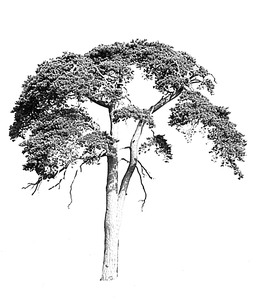Did you know?
Fascinating facts about trees.
Neolithic people began to convert wildwood into fields and pastures between 1,300 and 700 BCE
Rivers and trees were sacred to the Celts and the tribes who came to Britain after the Romans had left.
Alfred the Great 871-899CE held councils at Runnymede possibly under the branches of the Ankerwycke Yew which took root around 2000 years ago, it still stands. The Magna Carta contained a Charter of the Forest which set out the rights and freedoms of people living in the Royal Forests of England
The Saxon lords often planted trees at the corners of their lands to mark boundaries, one Saxon lord was called Coave hence the name Coventry. Boundaries are still marked by trees today.
Common or black alder: its timber was used to make clogs in the north of England and Norway.
Sycamore: Sycamore wood is used for making violins
Monkey Puzzle: The seeds were eaten as a dessert nut in south America. Archibald Menzies brought the first seeds to England in 1795 by slipping some nuts into his pocket when at a Chilean banquet.
Box: Boxwood is extremely hard and has been used for engraving since late medieval times. It also produces and extract which is used medicinally to purify the blood.
Hornbeam: The wood is used to make skittles making the distinctive sound when the ball hits the skittle.
Judas Tree; Can live to be thousands of years old. There is a longstanding myth that it is the tree from which Judas Isacariot hung himself.
Wellingtonia; Is the worlds largest living organism and one of the longest lived. Known to live up to 4000 years, it was introduced into England in 1853 by William Lob, who after two years had produced thousands of saplings for wealthy Victorians. It is known in America as the Washingtonia, after George Washington and in the UK as the Wellingtonia after the duke of Wellington. The tallest specimen is in California and is 94.9 metres or 311.4 feet tall.
Beech: The beech tree has edible nuts which are the source of oil that was extracted on a large scale in Germany during the two World Wars. It makes a type of margarine. Old-fashioned clothes-pegs are also usually made of beech
Ash: Is used to make snooker cues.
Ginko Biloba or the Maidenhair Tree: The only species of tree which survives from the time of the dinosaurs. It is also a Chinese temple tree.
Holly: Traditionally people carved their names in the trunks of old holly trees.
Juniper: The berries are used to flavour gin and in Norway to make a beer. Many of the earliest pre-historic peoples lived near Juniper forests.
Oak: The oak has root systems that penetrate the soil to depths of more than 30 m (100 ft) in search of water and can live up to 800 years old
Cedar of Lebanon: The best-known cedar is the cedar of Lebanon, mentioned often in the Old Testament; the First Temple of Solomon was built of this wood (1 Kings 5:6).
Rowan: In Britain it grows at higher altitudes than any other tree.
Lime: “Linden” is an old, alternative name for the lime tree. The lime blossom is an important source of nectar for honeybees.
Willow: The twigs of the common willow are grown for use in basket-making, and the light but dent-resistant timber of other willows is used for making artificial limbs, wooden shoes, and cricket bats. Aspirin is a derivative of salicylic acid, which was first synthesized from the bark of the willow.
Yew: Often planted in churchyards, there is a specimen at Runnymeade which is over 2,000 years old.
Rowan: Was once planted near houses in the Scottish Highlands to guard against witchcraft.
Coast Redwood: Thought to be the tallest tree in the world, one having reached 111 metres or 367 feet in California, there are two examples of this tree in Much Wenlock.
Norway Spruce: Or better known as the Christmas tree, it can grow to 36 metres or 120 feet tall.
Bay Tree: The ancient Romans made the leaves into wreaths to crown poets and heroes.
Mulberry: Has a delicious fruit and is believed to be the origin of the phrase ‘caught red handed’ as the juice leaves a dark stain.
Tupelo: The Tupelo tree planted on the church green to commemorate the birth of William Penny Brookes comes from the small town of Tupelo, near Memphis, Tennessee in the United States, which is also the birthplace of Elvis Presley
